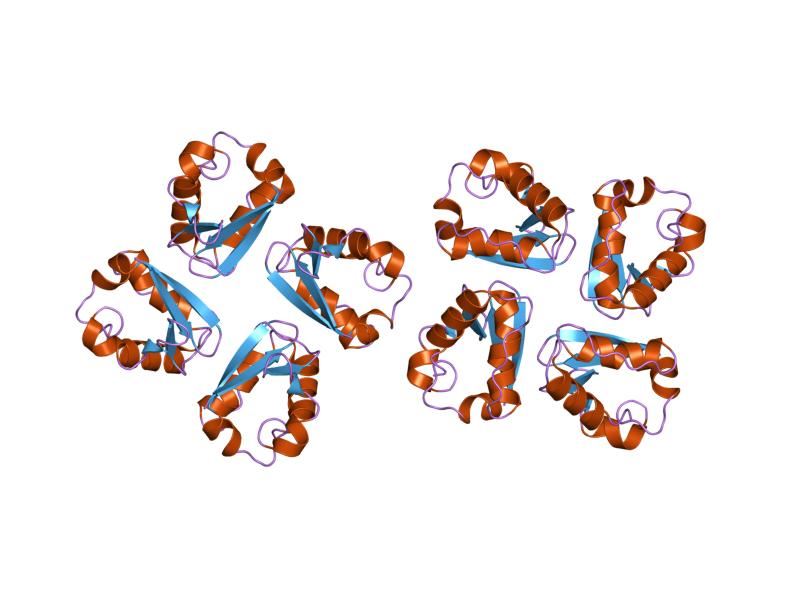Introduction of KCNA1
KCNA1, encoded by KCNA1 gene, is a member of potassium voltage-gated channel subfamily A which controls the transportation of potassium ion across membrane. The encoded protein has 495 amino acids and contains 6 putative membrane-spanning segments (S1-S6) with a voltage-sensor (S4) and the pore-loop between S5 and S6. The complete channel is a homotetramer. The N-terminus of the protein interacts with β subunits regulating channel inactivation. The C-terminus of the protein is involved in channel targeting by interacting with a PDZ domain protein.
| Basic Information of KCNA1 | |
| Protein Name | Potassium voltage-gated channel subfamily A member 1 |
| Gene Name | KCNA1 |
| Aliases | EA1, MK1, AEMK, HBK1, HUK1, MBK1, RBK1, KV1.1 |
| Organism | Homo sapiens (Human) |
| UniProt ID | P29274 |
| Transmembrane Times | 6 |
| Length (aa) | 495 |
| Sequence | MTVMSGENVDEASAAPGHPQDGSYPRQADHDDHECCERVVINISGLRFETQLKTLAQFPNTLLGNPKKRMRYFDPLRNEYFFDRNRPSFDAILYYYQSGGRLRRPVNVPLDMFSEEIKFYELGEEAMEKFREDEGFIKEEERPLPEKEYQRQVWLLFEYPESSGPARVIAIVSVMVILISIVIFCLETLPELKDDKDFTGTVHRIDNTTVIYNSNIFTDPFFIVETLCIIWFSFELVVRFFACPSKTDFFKNIMNFIDIVAIIPYFITLGTEIAEQEGNQKGEQATSLAILRVIRLVRVFRIFKLSRHSKGLQILGQTLKASMRELGLLIFFLFIGVILFSSAVYFAEAEEAESHFSSIPDAFWWAVVSMTTVGYGDMYPVTIGGKIVGSLCAIAGVLTIALPVPVIVSNFNYFYHRETEGEEQAQLLHVSSPNLASDSDLSRRSSSTMSKSEYMEIEEDMNNSIAHYRQVNIRTANCTTANQNCVNKSKLLTDV |
Function of KCNA1 Membrane Protein
KCNA1 functions as a potassium voltage-gated channel which controls potassium ions transport into and out of cells depending on electrochemical gradient. KCNA1 is mostly found in the axons of neurons throughout the central nervous system where it is involved in the regulation of membrane potential and nerve signaling. KCNA1 can control the rapid outflow of potassium thereby regulating membrane potential stabilization and repolarization after action potentials, avoiding neuronal hyperexcitability. Moreover, KCNA1 has been revealed to impair the presynaptic depolarization that promotes calcium ion channel opening and neurotransmitter release. Besides, KCNA1 also plays an important role in setting up the negative potential across the DCT luminal membrane and the negative potential drives magnesium transmembrane transport through TRPM6. In addition, biophysical studies have been shown that mutations in KCNA1 impair the properties of the channel including channel assembly, trafficking, and kinetics. And mutations in KCNA1 can lead to the rare episodic ataxia type 1 which is associated with sudden attacks of ataxia and with varieties of nervous system disorders including the hippocampal and peripheral nerve hyperexcitability and severe epilepsy.
 Fig.1 Cartoon representation of the molecular structure of KCNA1 protein registered with 1dsx code.
Fig.1 Cartoon representation of the molecular structure of KCNA1 protein registered with 1dsx code.
Application of KCNA1 Membrane Protein in Literature
The study shows a Leu328Val mutation of KCNA1 gene in a patient with tetany and hypomagnesemia. This is the second report which demonstrates the association between KCNA1 and hypomagnesemia.
The study suggests that Kcna1-null mice manifest progressive respiratory dysfunction with age. And this also increases the potential risk of respiratory failure during severe seizures.
The study indicates that the mutations in the KCNA1 gene lead to the potassium channel dysfunction that is associated with the occurrence of familial paroxysmal kinesigenic dyskinesia.
The study indicates that the mutant E283K in KCNA1 can decrease potassium current. And the heterozygous carrier is associated with episodic ataxia type 1 (EA1) symptoms.
The study demonstrates that a novel c.746T>G missense mutation of KCNA1 is associated with episodic ataxia and malignant hyperthermia.
KCNA1 Preparation Options
To obtain the soluble and functional target protein, the versatile Magic™ membrane protein production platform in Creative Biolabs enables many flexible options, from which you can always find a better match for your particular project. Aided by our versatile Magic™ anti-membrane protein antibody discovery platform, we also provide customized anti-KCNA1 antibody development services.
As a forward-looking research institute as well as a leading custom service provider in the field of membrane protein, Creative Biolabs has won good reputation among our worldwide customers for successfully accomplishing numerous challenging projects including generation of many functional membrane proteins. Please feel free to contact us for more information.
All listed services and products are For Research Use Only. Do Not use in any diagnostic or therapeutic applications.